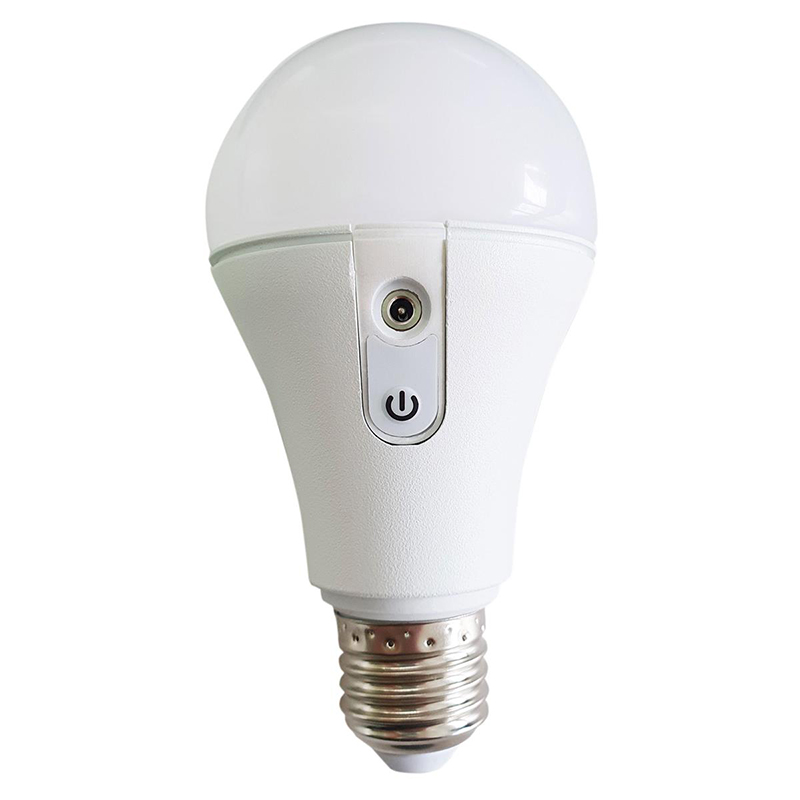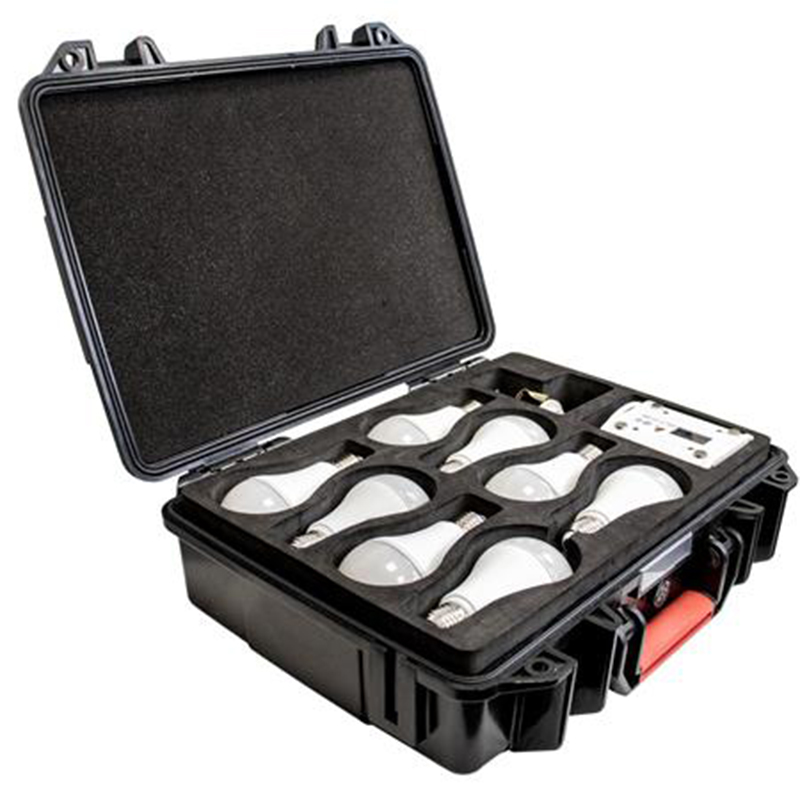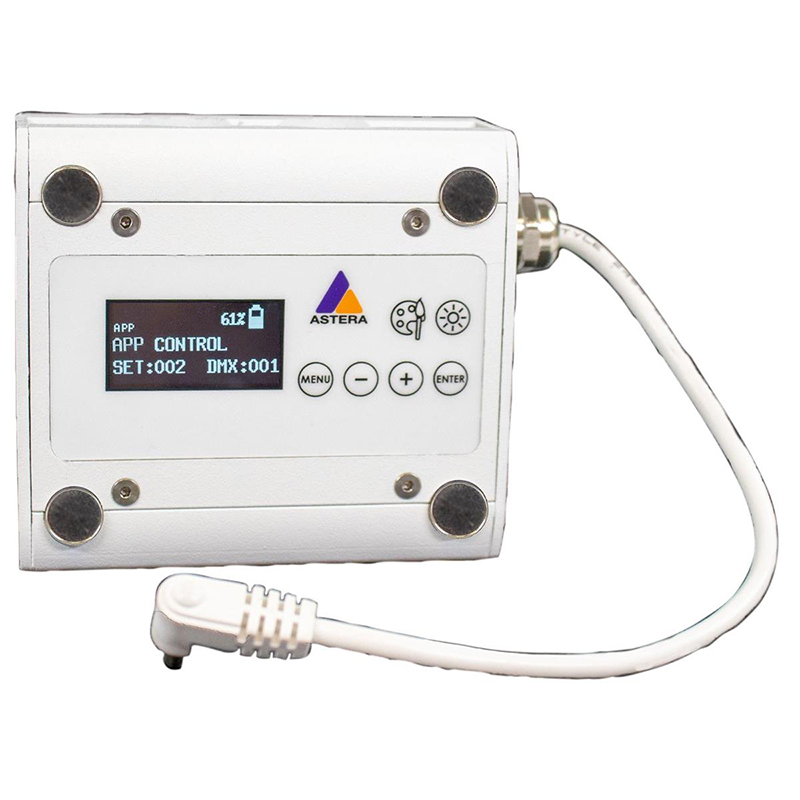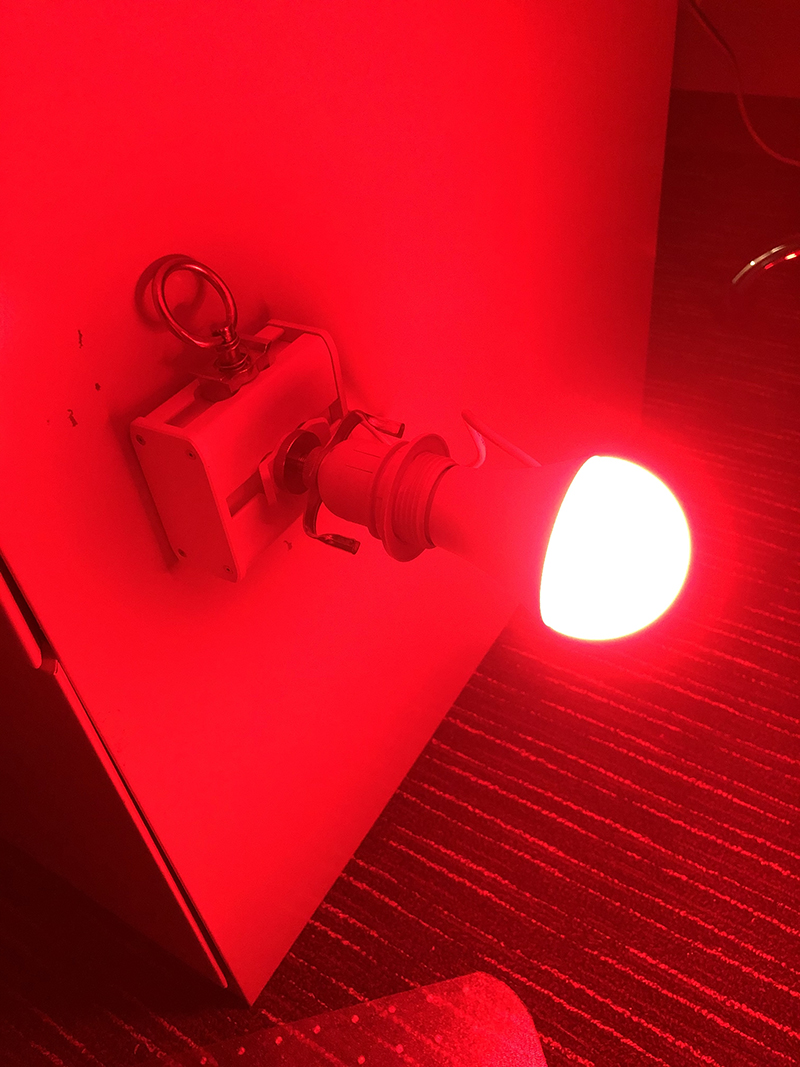
Programmable color temperature household light bulbs have been around for a couple years, though they are quite costly in comparison to regular ones and have proven to not be road worthy. DMX-able festoon bulbs have also come on strong. But the lighting industry was still in need of a bright, sturdy fixture that could change to any color, emit enough brightness to be more than a set practical, and work well with cameras. Astera has stepped up and filled that niche with the NYX bulb, which is the first color tunable LED bulb designed for the professional film, stage and event worlds.
The NYX package, like many other Astera fixtures, came to my office in a stealth Pelican style hard case designed by the company as well. All the contents arrived secured in perfect foam cutouts within the case. These include a square PowerStation (the brains, battery, and Wi-Fi module), a single bulb, an E 26 socket to hold the bulb, some accessories, and an outboard power supply to take in 100-240 volts and deliver 48 volts to the brain.

Setup and Mounting the Unit
The PowerStation is a rectangular case that measures 3.8 by 3.2 by 1.7 inches in size, and with the bulb attached, it weighs 1.8 pounds. Three of the long sides have airline tracks to easily slide in the lamp socket or any other accessories. The fourth wide side of the box has an LCD screen for onboard standalone programming or setting up Bluetooth/Wi-Fi control of the device. Since the NYX can operate off a battery, there is a panel mount connection to receive the DC input from the external power supply.
I found four different ways I can mount this unit for use. The easiest is that the NYX can simply sit on its PowerStation base, using it as a sturdy floor stand. In this fashion, the user just plops the fixture anywhere on a stage, and it becomes a set practical. Along the side that has the LCD, I find four magnets on the corners. This will prevent the fixture from moving with vibration when placed on anything metallic. But I decide to see how this unit will fare with the bulb sticking outwards from the magnets. I slap it on the underside of my desk, and after sliding a couple inches, it held steady for hours, though I am unsure if this is a great idea for permanent use. The fixture also comes with an optional utility ring that one can easily slide in any groove and hang it from a safety line on a truss or under a scenic piece. The fourth way to mount the light is via the grip mode. The fixture has an accessory for mounting the whole thing on a stand/grip head or a super clamp via an optional Astera TrackPin.
The lamp socket looks like any ordinary household one, and it even includes a typical mount device to add any lampshade to it. However, the DC and signal for the lamp come from the cable attached directly to the side of the 10W bulb itself in my setup with the PowerStation engaged. The PowerStation is not necessary to run the fixture and is just an optional accessory that can really aid in programming. The NYX can alternately be plugged into a normal 100-240V lamp socket and get fed power through that, while accepting signal via a USB cable connected to a hub, if desired. Another available option features a DC socket for connecting external batteries or power banks, for which a USB cable is included with the NYX Bulb.
The bulb is just slightly longer than a typical household bulb and has an on/off switch itself. To engage, the user must hold the button down for a full second to activate. The NYX package I received includes a generic 48 volt power supply capable of handling 24 watts. This charges the battery in the PowerStation and can stay connected forever if permanently installed. The total charge time recommended is five hours, and the battery life is 3.5 hours when run constantly at full white intensity. The total setup time for me was two minutes.

Operation and Control
I ran the NYX in general RGBW mode with a strobe and dimmer channel from a console just to verify it works well from a light desk. But for the purposes of this article I will test each function in standalone mode.
There are a few ways to control the bulb, all of which are simple. While I choose to test it in Standalone mode attached to the PowerStation, I can also opt to fire it up via the AsteraApp, but at the moment, I need to use an AsteraBox to do this. In the near future, the box will not be necessary and the bulb will be able to run directly from my cell phone via Bluetooth while getting power from the socket. It can also be run off of any CRMX transmitter as the bulb has a receiver built into it.
The bulb itself is comparable in output to a 60W household LED bulb, emitting 750 lumens. The Titan LED engine installed utilizes RGB, Mint and Amber LEDs to mix any hue or CCT. It has a naturally ultra-high CRI of 96+ and TLCI. While setting up the fixture, I see over 20 various DMX personalities one can choose from. I prefer the RGBW one with a separate dimmer and strobe control channel, as this is what I would require on a film shoot.
One doesn’t require a manual to quickly figure out how to program this fixture. On top of the PowerStation’s LCD panel are two dials, one with a “Brightness” icon to control dimming levels and another that looks like a painter’s palette for adjusting color. Below them are four buttons to adjust levels of these two features. On the left is a Menu button followed by +/- buttons and an Enter key.
I turn the intensity to full, and the bulb pops on in white. I notice there is also a channel for fade time. Once on, I switch over to the color presets to see how they operate. The first option is to adjust the color temperature, which ranges from a 1750° amber all the way up to 20K of white. This color temperature stays current until told to change. I back it down to a respectful 5K to see how the colors read. The next channel on the menu is the amount of green you want visible in the emitted beam, to make it look good with the particular camera being used. After that, we have Hue and Saturation levels for colors. The Hue pretty much follows the rainbow of colors over 360 various steps. At 0% the bulb is at its deepest red color and has variances that lighten it until it hits the orange/amber range at about 30. By the time the hue level hits 50, we see a nice yellow. The rest of the colors are all there, from soft pastels to rich primary colors. The lavender is what users will expect from an LED-sourced fixture, but the teal and magenta colors are stellar. Of course, no matter what hue I pick, if I keep the saturation level at 0, the fixture remains white.
I’m also told there is a way to make the NYX emulate the gel numbers of certain manufacturers. Meanwhile, the strobe function works well and where it really excels is on camera. Users can adjust the strobe rate until it looks really good and syncs with the shutter speed of the camera. Similar to the Astera Titan Tubes, this strobe effect is great for catching actors’ faces in dim light and giving them a glow. I attach the “cup bouncer” to the actual bulb. This is a white piece of rounded cardboard with a suction cup attached. It can be applied to the bulb to redirect the light waves so they are not omnidirectionally dispersed, blocking light from illuminating undesirable objects in the scene. Such a simple, but very effective, option.
One can set the run time to any amount up to 20 hours. Once that is set, the bulb will adjust its output level to an amount that will last the full dedicated time. I can noticeably see the bulb get brighter as I lower down the programmed run time. In a live mode, users would set the run time at 0, which means the fixture is running at maximum intensity until the battery runs dry. With the outboard power supply plugged in to my PowerStation, the battery stays charged. I will note that the bulb itself is set in a hardened casing that will not easily break like a household bulb.
Currently available through Astera’s global distribution network, NYX Bulbs are available as single units or in sets of eight, complete with a PowerStation inside the case for charging and programming the bulbs. The PowerStation is also available as a single stand-alone unit or as a set of eight in a charging case, for setting up multiple NYX Bulbs rapidly.

At a Glance:
A Simple New Softlight Solution
The Astera NYX fills the need of many gaffers for a simple, up close soft light that aids a cameraman while not blinding a performer.
PROS: Durable hardware, great mounting options, amazing range of CCT, full palette of all colors. Controllable in many ways, in many modes. Individually calibrated bulbs for matching. Can match effects to a beat.
CONS: None

FEATURES
- Luminous Flux: 750lm
- TLCI (3200-6500K): ≥96
- CRI (3200-6500K): ≥96
- Strobe: 0-25Hz
- Beam Angle: 120˚
- Field Angle: 180˚
- Each bulb allows AC and DC power
- Wireless Modules: UHF, CRMX, Bluetooth
- DMX: Wireless DMX (CRMX)
- IP Rating: IP44
STATS
- LED Source: Titan LED engine with RGB, Mint and Amber
- Wattage: 10 Watts
- Power Input: 100-240v or USB or PowerStation
- PWM: Flicker-free modulation
- Size of Bulb: 2.38” at widest width; 4.375” in length
- Weight: .5 lbs.
- MSRP: $130 for a single bulb with socket and USB cable
Manufacturer: Astera
More Info: www.astera-led.com


